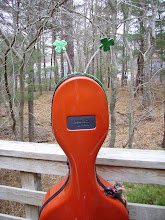Carol, Marilyn B, and I (my name is also Marilyn, as I may have mentioned) play together in a cello trio.I met Marilyn in my flute group. She started out on cello in school, but switched to flute. When my flute was in need of repair, she loaned me her flute, a very good flute, for over a year, while I scraped together the money to have my flute repaired. (The original estimate was $800, but it finally got down to $550 or so.)
So, I found it easy to loan her my second cello for an unspecified amount of time so she could play with us. She is a good flutist, and you would not know, to hear her play the cello, that she has not played in 40 or 50 years. She is doing well, and happily content to play the lower parts, while Carol and I argue about who should play first. ("You!" "No, you!")
We have worked out an easy system: we take three pieces at a time, each of us selecting one on which to play first. It has been hard to get the three of us together at the same time this summer, what with work, travel, and longing to spend a day at the beach. We are currently focused on three pieces and will have a coaching session in October with my and Carol's teacher, after MB returns from a month away. We will wait until she has had an opportunity for a lesson with our teacher so we will all go into the coaching session with a pre-coaching lesson.
We are using Suzuki music for our first set of trios. I am playing "Chanson Triste" by Tchaikovsky using the Suzuki arrangement in which I play the entire melody line and parts 2 and 3 play supportive roles. I have this for memory now, and my teacher thinks it sounds great, full of expression. I agree, most of the time, when I am playing it, but when I record it and listen back, I am dismayed. Horrified. (no, I can't blame this on the quality of recording. My teacher's cello playing sounds great.)
It sounds like I am anticipating the beat, not letting the notes linger long enough. I am working on expressiveness. This is a good piece for it.
It has been interesting to play this piece as ensemble--helped to point out to me two spots where I was lingering too long on a note. Yes, my teacher had pointed out these spots, but playing in an ensemble helps to make the point. (This is in tenor clef, if the fingerings look odd. The circled note in measure 33 is one I hang on to.)
Carol is playing Marie's "La Cinquantaine," choosing an arrangement for cello quartet in which the melody moves around among the parts. She has re-arranged it to take back some of the melody from MB because it is beyond her comfort zone right now. Both Carol and I use Coda Finale a lot to transpose, arrange, or otherwise manipulate music. Carol's work is often a great help, putting three parts into a score, for instance, so we can see what is happening in the other parts as we play. And in this case, making a quartet into a trio.
I am enjoying revisiting "La Cinquantaine," and it has inspired me to revisit all the pieces in books 1 to 4 (I am in book 5 at the moment), re-memorizing, re-understanding fingerings, improving intonation, and working on improving my vibrato. Very helpful. More on this later. (I really don't know what book Carol is in, but she is ahead of me. Our teacher does through books 5 through 8 out of order, so we each have all three of those books.)
MarilynB is playing "Berceuse" by Shubert and it sounds good. Carol and I have simple parts (this is the Suzuki arrangement), and the emphasis is on intonation and harmony.
I am hopeful we can eventually sound good enough to perform somewhere, perhaps at the nursing home where both the flute group and the cello trio rehearse. I think a combined flute and cello recital would be best, and more interesting for the audience. We shall see!
Subscribe to:
Post Comments (Atom)













No comments:
Post a Comment